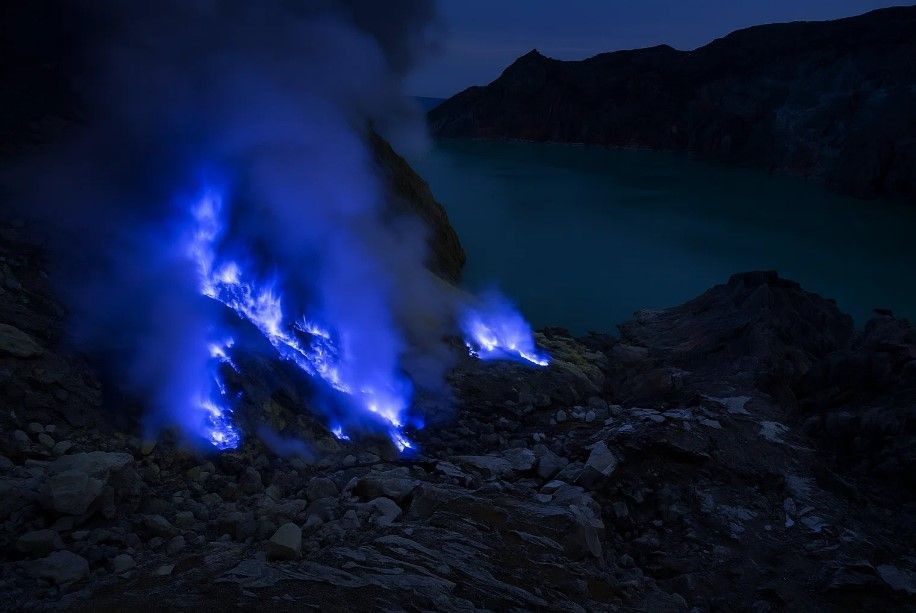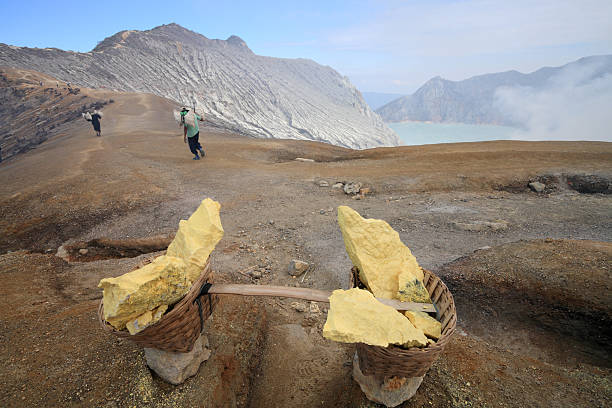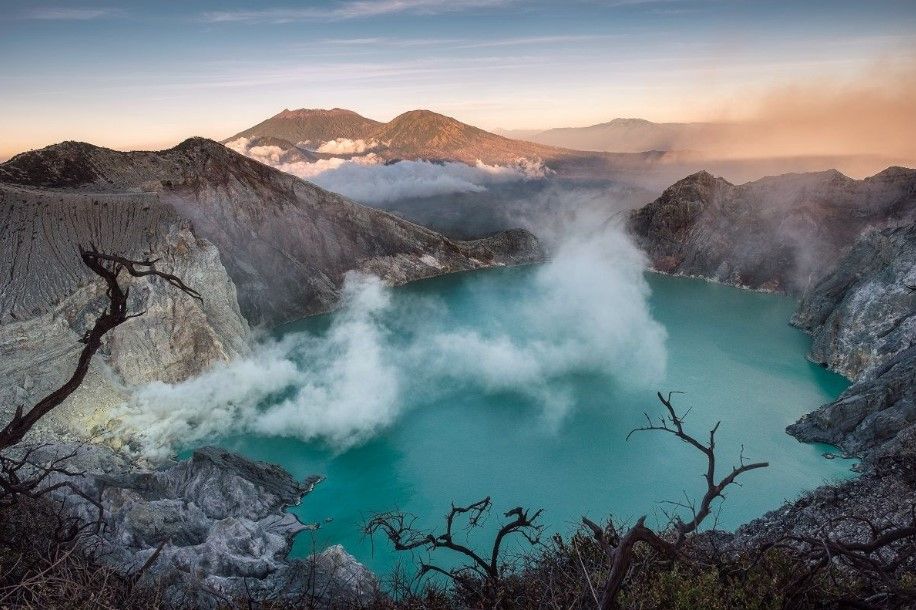Nestled in the heart of East Java, Indonesia, Kawah Ijen is a spectacular volcanic crater that attracts adventurers and nature lovers from all over the world. Famous for its mesmerizing blue flames, turquoise sulfur lake, and dramatic volcanic landscape, this natural wonder is one of the most unique travel destinations in Southeast Asia. Located in the Bondowoso and Banyuwangi regencies, Kawah Ijen is more than just a hiking spot—it's an experience that blends natural beauty, physical challenge, and cultural insight.
According to Lensa Nusantara, Kawah Ijen has consistently drawn international attention not only for its geological wonders but also for the powerful human stories surrounding its sulfur mining traditions.
1. Introduction to Kawah Ijen
Kawah Ijen is part of the Ijen volcano complex, which consists of several volcanoes, including Mount Merapi (not to be confused with the more famous Mount Merapi in Central Java). The Ijen crater stands at an altitude of about 2,386 meters (7,828 feet) above sea level and features the world’s largest highly acidic crater lake, glowing in a surreal shade of turquoise.
What truly sets Kawah Ijen apart is the electric-blue flames that emerge from cracks in the volcano. These flames are the result of sulfuric gases igniting upon contact with air, creating an eerie but beautiful spectacle that can only be witnessed in the darkness of night.
2. How to Get There
Kawah Ijen can be accessed from two main routes—Bondowoso and Banyuwangi. Many travelers prefer the Bondowoso route for a more serene and less crowded experience. From Bondowoso city, it takes about 2.5 to 3 hours to reach the Paltuding basecamp, the main starting point for the trek.
Getting to Bondowoso itself requires some planning. The nearest airports are in Surabaya (Juanda International Airport) or Banyuwangi, followed by a road trip via car or bus. Public transportation is available, but hiring a private vehicle or joining a tour is highly recommended for comfort and convenience.
3. Trekking the Ijen Crater
Citing from the BULETIN page, the trek to the crater starts from Paltuding Post, at around 1,850 meters above sea level. The hike is about 3 kilometers (1.9 miles) long and typically takes 1.5 to 2 hours, depending on your fitness level. The trail is fairly straightforward, but the first kilometer is steep and can be physically demanding, especially in the dark and cold of early morning.
Most hikers begin the trek at around 1:00–2:00 AM to catch the blue flame phenomenon, which is only visible before sunrise. It’s advisable to wear layers, as temperatures at the top can drop below 10°C (50°F), and bring a gas mask or rent one at the basecamp to protect against sulfur fumes.

4. The Blue Flame Phenomenon
The blue fire of Ijen is one of only two such phenomena in the world (the other is in Iceland). Contrary to common belief, it’s not actual lava that glows blue. Instead, it’s the result of sulfur gases emerging at high temperatures (over 600°C) from cracks in the volcano. These gases ignite when they meet the oxygen-rich atmosphere, producing a bright blue glow.
This incredible natural show can be seen best between 2:00 AM and 4:00 AM, so reaching the crater before then is essential. After sunrise, the flames become invisible due to daylight.
5. The Sulfur Miners of Ijen
One of the most humbling aspects of visiting Kawah Ijen is witnessing the sulfur miners who work under extremely harsh conditions. These men manually extract sulfur from the crater and carry baskets weighing up to 70–90 kilograms (154–198 pounds) up and down the mountain, earning only a modest wage.

Despite the toxic fumes and physical toll, these miners often greet tourists with a smile and are open to sharing their stories. Some even carve miniature sulfur statues, which they sell as souvenirs. Watching them work is both inspiring and heartbreaking, and serves as a stark reminder of the human endurance behind Ijen’s beauty.
6. The Acidic Crater Lake
At the heart of the Ijen crater lies a lake that is as beautiful as it is dangerous. The turquoise-colored lake is the world’s largest highly acidic lake, with a pH of nearly zero. Its color comes from the dissolved metals and minerals within the water, making it a stunning sight for photographers and nature lovers alike.
Visitors are advised not to get too close to the water due to its toxic nature and the unpredictable gas emissions in the area. However, the view from the crater rim is more than enough to leave a lasting impression.
Check us out on: Ijen Kaldera: Warisan Letusan Dahsyat yang Menjadi Surga Wisata
7. Best Time to Visit
The best months to visit Kawah Ijen are during the dry season, from April to October. During this time, the skies are clearer, the paths are less slippery, and the risk of volcanic activity is lower. Nighttime treks are cold and require proper gear, so make sure to prepare accordingly.
Avoid the rainy season (November to March), as the trail becomes more difficult and dangerous, and the visibility is often poor due to fog and clouds.
8. Accommodation and Tour Options
In Bondowoso, you’ll find a range of guesthouses, homestays, and eco-lodges catering to travelers heading to Ijen. Many tour operators offer Ijen packages that include accommodation, transportation, a guide, and equipment rental.
Staying overnight in Bondowoso allows you to rest before the early morning trek and experience more of the local culture. Some accommodations are located in scenic rural areas surrounded by coffee plantations and rice fields, offering a peaceful escape from the crowds.
9. Tips for a Safe and Enjoyable Visit
Bring a flashlight or headlamp, as the trail is dark and rocky.
Wear sturdy hiking shoes with good grip.
Carry enough water and snacks, as there are no vendors during the hike.
Use a gas mask when descending into the crater.
Follow local guides’ instructions to ensure your safety.
Respect the environment and local workers—don’t leave trash behind or disrupt the miners.
10. Conclusion
Kawah Ijen in Bondowoso is a one-of-a-kind destination where nature’s power and beauty collide in spectacular ways. From the glowing blue fire to the silent struggles of sulfur miners and the surreal acidic lake, every aspect of Ijen tells a story. It’s not just a tourist attraction—it’s an emotional and sensory journey.
For those seeking more than just photos and checklists, Kawah Ijen offers a deeply meaningful adventure. It challenges your body, stirs your emotions, and leaves you with memories that last a lifetime.
